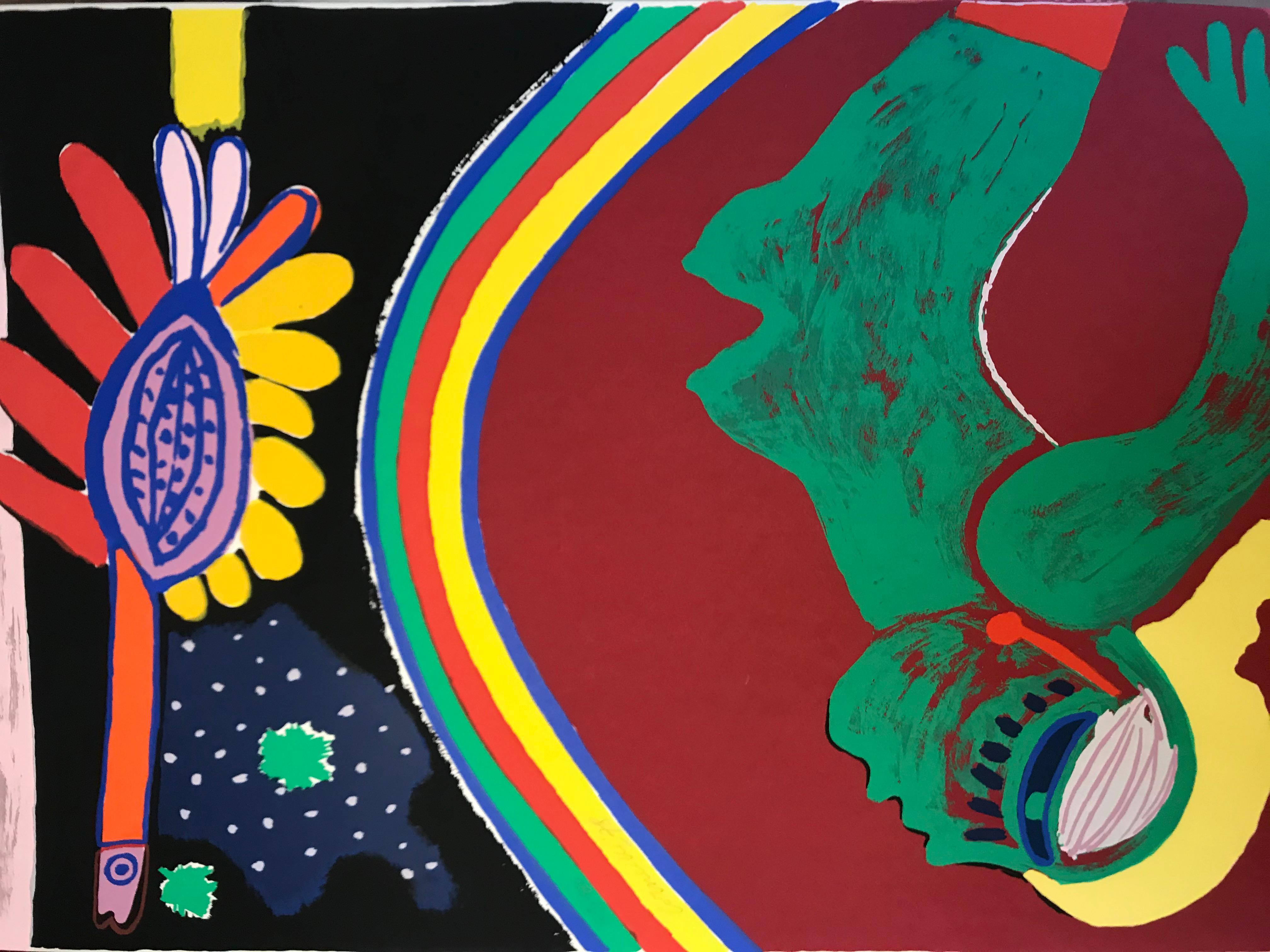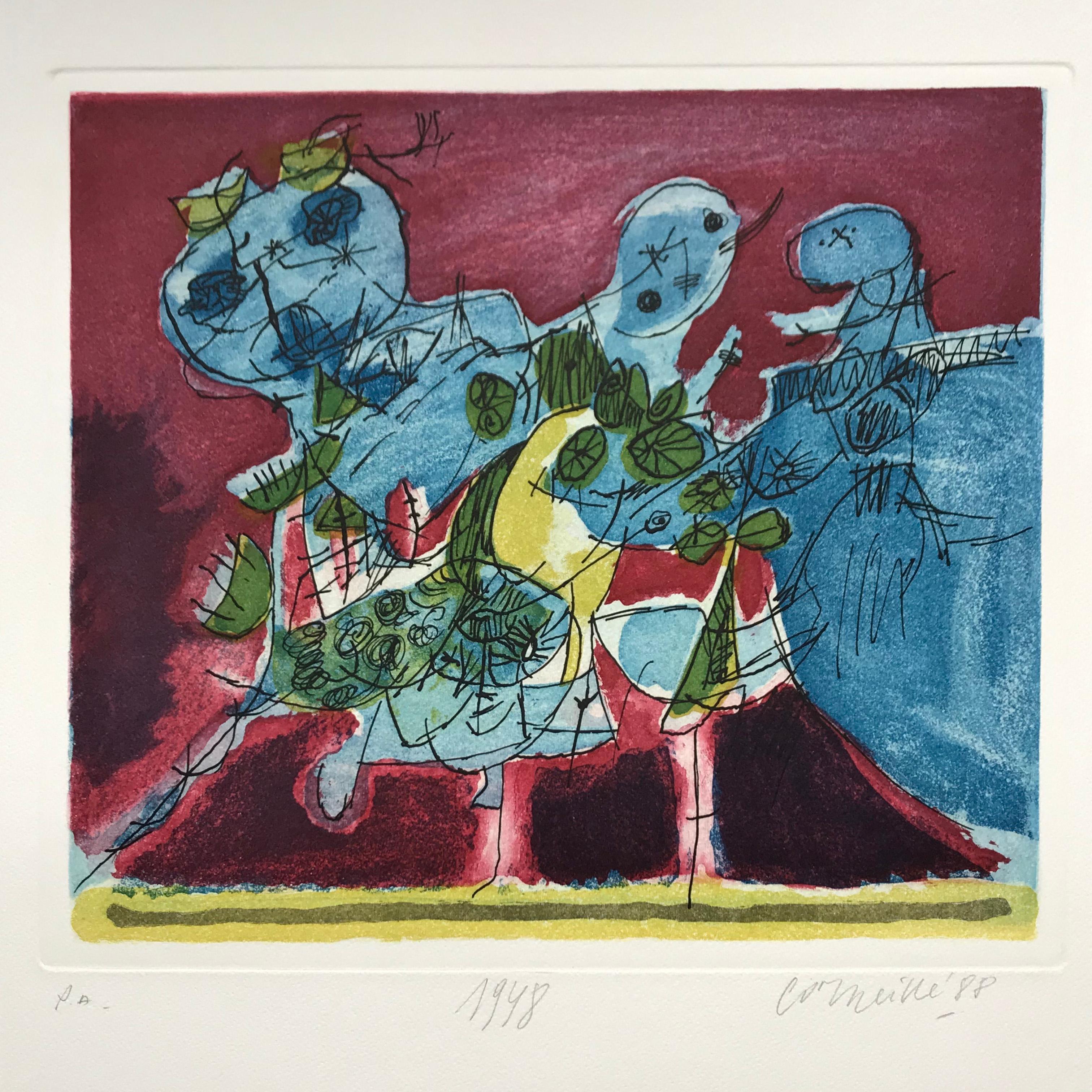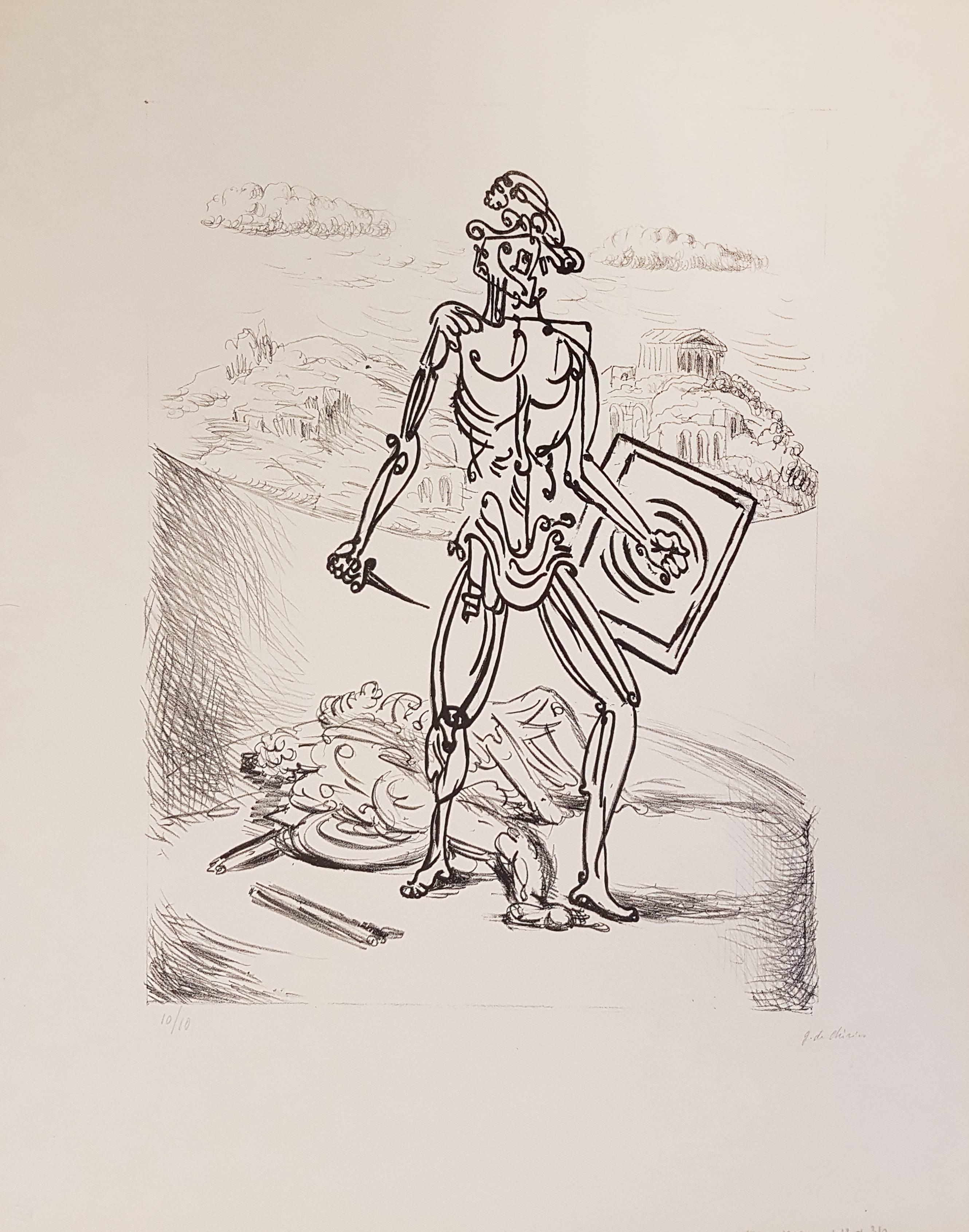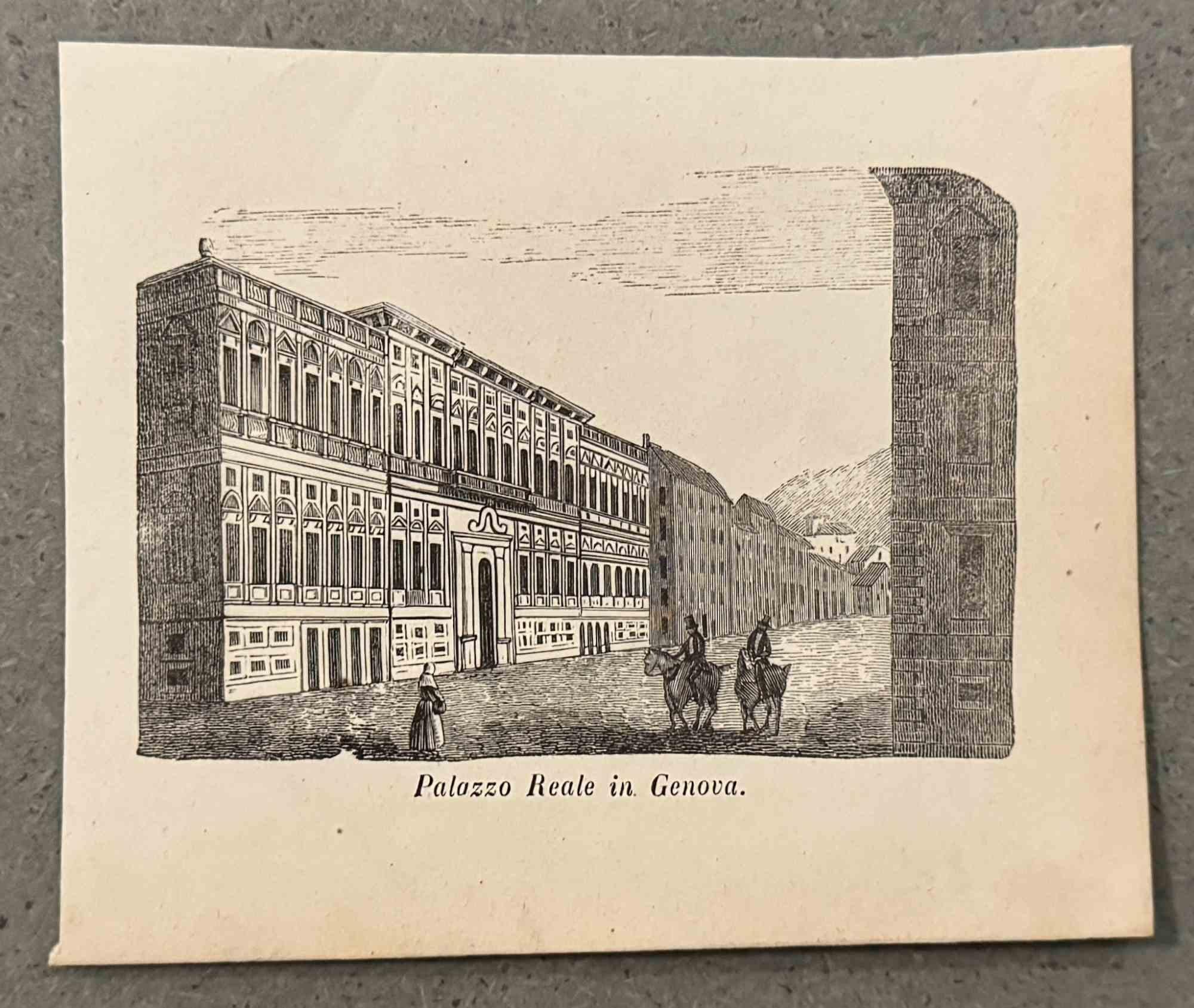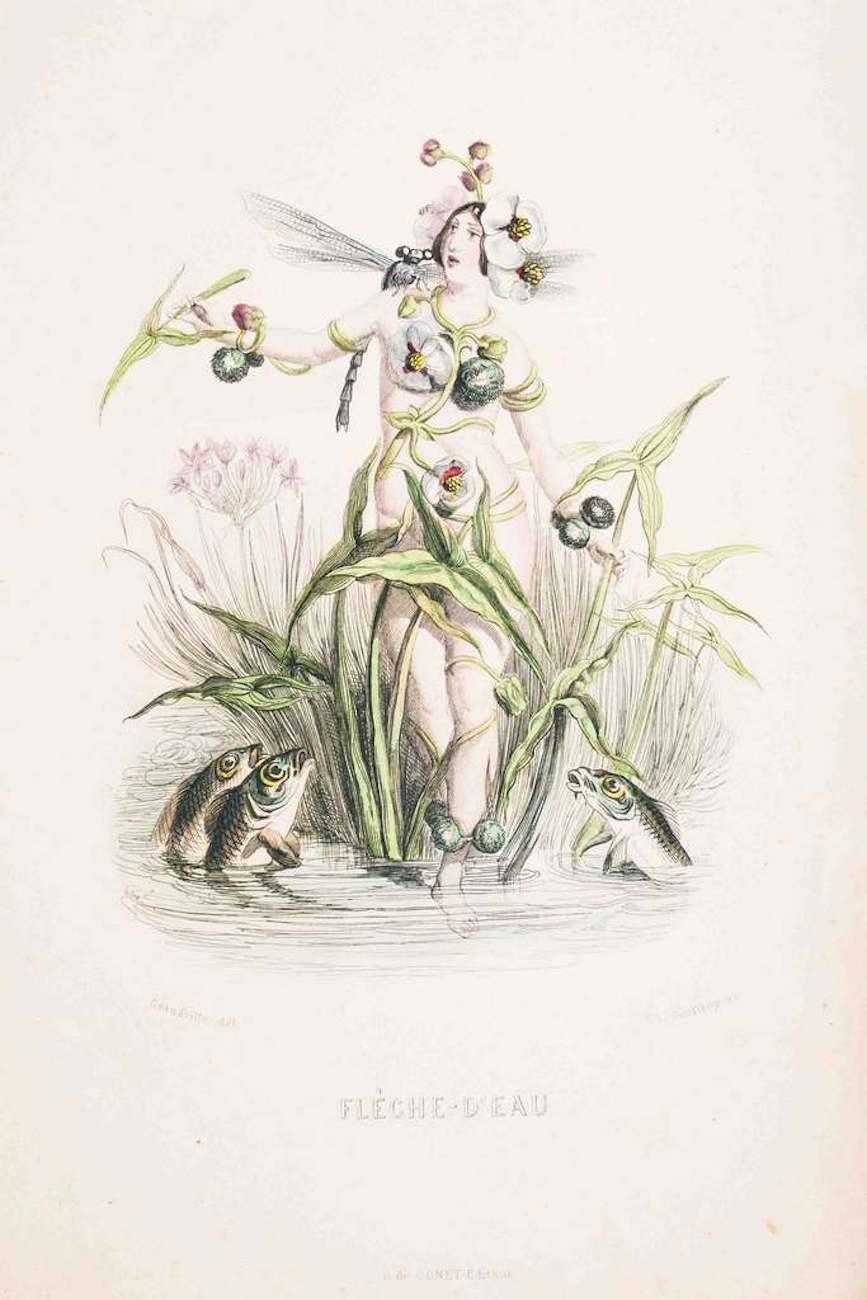Items Similar to The Dream
Want more images or videos?
Request additional images or videos from the seller
1 of 10
Will BarnetThe Dream2002
2002
About the Item
Will Barnet
"The Dream" 2002
Color Lithograph on Somerset Velvet White Paper
Signed and Titled
Ed. 250
Will Barnet, Visionary Artist, Dies at 101
By KEN JOHNSON
Published: November 13, 2012
Will Barnet, a printmaker and painter known for elegantly stylized portraits and classically composed visions of beautiful women and children, died on Tuesday at his home in Manhattan. He was 101.
His death was announced by Philippe Alexandre, whose gallery represented him. He had lived in the National Arts Club building on Gramercy Park since 1982.
In the prints and paintings that he produced from the mid-1960s on, Mr. Barnet ranged between a simplified form of realism and a poetic, visionary symbolism. A skilled draftsman, he created exactingly linear, subtly colored portraits of family members and friends. In the enigmatic pictures he began making in the 1970s, he conjured images of women in dark woods or on the porches of seaside houses who appear to be waiting for loved ones like 19th-century sailors' wives.
A native of Beverly, Mass., Mr. Barnet attended the School of the Museum of Fine Arts in Boston and, on a scholarship, went to New York to study at the Art Students League, arriving in 1931, he once said, with $10 and a portfolio of seascapes and portraits of the family cat. He worked briefly under Stuart Davis and became acquainted with the Surrealist artist Arshile Gorky.
Mr. Barnet started out as a Social Realist printmaker responding to the struggles of ordinary people during the Depression. He was "radicalized" at 19, he said, roaming the city and sketching the faces of the downtrodden while renting a room for $1 a night.
Four years after joining the Art Students League he was appointed its official printer. He went on to work in graphic arts for the Depression-era Works Progress Administration Federal Art Project. He also made prints for the Mexican muralist José Clemente Orozco and the painter and political cartoonist William Gropper.
Mr. Barnet had his first solo exhibition at the Eighth Street Playhouse in Manhattan in 1935 and, three years later, his first gallery show at the Hudson Walker Gallery, also in Manhattan. That same year he married Mary Sinclair, a painter and fellow student, with whom he had three sons. In 1939 his work was included in "American Art Today" at the New York World's Fair.
Eventually his interest in Modernist formal innovations led to colorful, Picassoesque paintings depicting domestic family scenes, often featuring young children, and by the end of the 1940s his paintings had become entirely abstract. He soon fell in with a group known as the Indian Space Painters, who created geometrically complex abstract paintings using forms derived from both Native American art and modern European painting.
But Mr. Barnet returned to traditionalist representational painting in the early 1960s. Under the influences of early Renaissance painting, Japanese printmaking and, perhaps obliquely, Pop Art, he made flattened, precisely contoured portraits of the architect Frederick Kiesler, the art critic Katherine Kuh and the art collector Roy Neuberger.
By then he was divorced and had married Elena Ciurlys in 1953. They had a daughter, Ona, and both she and her mother were subjects of his portraits as well. His later images of mysterious waiting women showed the influences of Pre-Raphaelite narratives, Magritte's Surrealism and Edward Hopper's taciturn romanticism.
In 2003 Mr. Barnet again changed course, returning to abstraction and resuming the engagement with bold shapes, vivid color and dynamic compositions that characterized his painting in the 1950s. He continued to work into his 90s, and in 2010 he was honored with an exhibition, "Will Barnet and the Art Students League," at the Phyllis Harriman Mason Gallery in Manhattan. He began teaching graphic arts and composition for the league in 1936, became an instructor of painting and continued to teach at the school until 1980.
"I didn't compromise, ever," he said in an interview with The New York Times on the occasion of the exhibition. "The old masters are still alive after 400 years, and that's what I want to be."
Mr. Barnet was born on May 25, 1911. His father, Noah, who had immigrated from Russia, was a machinist in a shoe factory. His mother, Sarahdina, came from Eastern Europe. Mr. Barnet became interested in art as a child and by age 12 had his own studio in his parents' basement.
He is survived by his wife, as well as his sons from his first marriage — Peter, a painter; Richard, a sculptor; and Todd, a lawyer — and the daughter from his second marriage, Ona, who owns and operates an inn in Maine; nine grandchildren; and three great-grandchildren.
In addition to the Art Students League, Mr. Barnet taught at the Cooper Union for the Advancement of Science and Art from 1945 to 1978 and, in shorter stints, at Yale, the Pennsylvania Academy of Fine Arts, and other schools. He was awarded a National Medal of Arts from 2011, which was presented by President Obama in a White House ceremony this year.
It was in 2011 when the Montclair Art Museum in New Jersey exhibited a selection of his canvases in honor of his centennial year. His work was also shown in many solo and group shows around the United States, including six appearances in the Whitney Museum of American Art's annual exhibitions. He was the subject of several museum retrospectives. "Will Barnet at 100," presented at the National Academy Museum in 2011, was the last. It was also his first solo retrospective in New York.
Mr. Barnet's first encounters with art were the carvings of skeletal heads and other images on colonial tombstones in a local cemetery in Beverly.
"These were mementos of what had taken place," he recalled. "At the age of 10 or 12, I discovered that being an artist would give me an ability to create something which would live on after death."
Daniel E. Slotnik contributed reporting.
- Creator:Will Barnet (1911, American)
- Creation Year:2002
- Dimensions:Height: 24 in (60.96 cm)Width: 16 in (40.64 cm)
- Medium:
- Movement & Style:
- Period:
- Condition:
- Gallery Location:Missouri, MO
- Reference Number:1stDibs: LU74735758051
Will Barnet
At the beginning of his career, Will Barnet was known for his figural depictions of domestic scenes. But, as he continued to stylistically develop, Barnet arrived at abstract geometric paintings far removed from his original career. A part of the Indian Space Painters group, Barnet was inspired by Native American art in creating these divergent images. Throughout his career, Barnet oscillated between representational and abstract paintings, never fully settling on one. He has received the National Medal of Arts in 2011, and his work has been displayed at the Whitney Museum of American Art, the Museum of Modern Art, and the Metropolitan Museum of Art.
About the Seller
5.0
Vetted Seller
These experienced sellers undergo a comprehensive evaluation by our team of in-house experts.
Established in 1970
1stDibs seller since 2017
142 sales on 1stDibs
Typical response time: 20 hours
- ShippingRetrieving quote...Ships From: Missouri, MO
- Return PolicyA return for this item may be initiated within 2 days of delivery.
More From This SellerView All
- Study/Falling Man (Series II)By Ernest Tino TrovaLocated in Missouri, MOStudy/Falling Man (Series II), 1967 By. Ernest Tino Trova (American, 1927-2009) Signed in Pencil Lower Right Color Lithograph Unframed: 6 x 6 inches With Frame: 8.75 x 8.5 inches Kn...Category
20th Century American Modern Abstract Prints
MaterialsLithograph
- Bareback Act, Old HippodromeBy Gifford BealLocated in Missouri, MOBareback Act, Old Hippodrome By Gifford Beal (1879-1956) Signed Lower Right Unframed: 6.5" x 9.5" Framed: 17.5" x 20" Gifford Beal, painter, etcher, muralist, and teacher, was born in New York City in 1879. The son of landscape painter William Reynolds Beal, Gifford Beal began studying at William Merritt Chase's Shinnecock School of Art (the first established school of plein air painting in America) at the age of thirteen, when he accompanied his older brother, Reynolds, to summer classes. He remained a pupil of Chase's for ten years also studying with him in New York City at the artist's private studio in the Tenth Street Studio Building. Later at his father's behest, he attended Princeton University from 1896 to 1900 while still continuing his lessons with Chase. Upon graduation from Princeton he took classes at the Art Students' League, studying with impressionist landscape painter Henry Ward Ranger and Boston academic painter Frank Vincent DuMond. He ended up as President of the Art Students League for fourteen years, "a distinction unsurpassed by any other artist." His student days were spent entirely in this country. "Given the opportunity to visit Paris en route to England in 1908, he chose to avoid it" he stated, "I didn't trust myself with the delightful life in ParisIt all sounded so fascinating and easy and loose." His subjects were predominately American, and it has been said stylistically "his art is completely American." Gifford achieved early recognition in the New York Art World. He became an associate member of the National Academy of Design in 1908 and was elected to full status of academician in 1914. He was known for garden parties, circuses, landscapes, streets, coasts, flowers and marines. This diversity in subject matter created "no typical or characteristic style to his work." Beal's style was highly influenced by Chase and Childe Hassam, a long time friend of the Beal family who used to travel "about the countryside with Beal in a car sketching...Category
20th Century American Modern Animal Prints
MaterialsLithograph
- Le Christ a l'Horloge, ParisBy Marc ChagallLocated in Missouri, MOMarc Chagall "Le Christ a l'Horloge, Paris" (Christ in the Clock) 1957 (M. 196) Color Lithograph on Arches Wove Paper Signed in Pencil "Marc Chagall" Lower Right Initialed "H.C." (Hors Commerce) Lower Left, aside from numbered edition of 90 *Floated in Gold Frame with Linen Matting, UV Plexiglass Sheet Size: 18 3/4 x 14 3/4 inches (47.5 cm x 38 cm) Image Size: 9 3/4 x 8 1/2 inches Framed Size: 28.5 x 24.25 inches Marc Chagall was a man of keen intelligence, a shrewd observer of the contemporary scene, with a great sympathy for human suffering. He was born on July 7, 1887 in Vitebsk, Russia; his original name was Moishe Shagal (Segal), but when he became a foremost member of the Ecole de Paris, he adopted French citizenship and the French spelling of his name. Vitebsk was a good-sized Russian town of over 60,000, not a shtetl. His father supported a wife and eight children as a worker in a herring-pickling plant. Sheltered by the Jewish commandment against graven images, the young Chagall never saw so much as a drawing until, one day, he watched a schoolmate copying a magazine illustration. He was ridiculed for his astonishment, but he began copying and improvising from magazines. Both Chagall's parents reluctantly agreed to let him study with Yehuda Pen, a Jewish artist in Vitebsk. Later, in 1906, they allowed their son to study in St. Petersburg, where he was exposed to Russian Iconography and folk art. At that time, Jews could leave the Pale only for business and employment and were required to carry a permit. Chagall, who was in St. Petersburg without a permit, was imprisoned briefly. His first wife, Bella Rosenfeld, was a product of a rich cultivated and intellectual group of Jews in Vitebsk. Chagall was made commissar for the arts for the area, charged with directing its cultural life and establishing an art school. Russian folklore, peasant life and landscapes persisted in his work all his life. In 1910 a rich patron, a lawyer named Vinaver, staked him to a crucial trip to Paris, where young artists were revolutionizing art. He also sent him a handsome allowance of 125 francs (in those days about $24) each month. Chagall rejected cubism, fauvism and futurism, but remained in Paris. He found a studio near Montparnasse in a famous twelve-sided wooden structure divided into wedge-shaped rooms. Chaim Soutine, a fellow Russian Jew, and Modigliani lived on the same floor. To Chagall's astonishment, he found himself heralded as one of the fathers of surrealism. In 1923, a delegation of Max Ernst, Paul Eluard and Gala (later Salvador Dali's wife) actually knelt before Chagall, begging him to join their ranks. He refused. To understand Chagall's work, it is necessary to know that he was born a Hasidic Jew, heir to mysticism and a world of the spirit, steeped in Jewish lore and reared in the Yiddish language. The Hasidim had a special feeling for animals, which they tried not to overburden. In the mysterious world of Kabbala and fantastic ancient legends of Chagall's youth, the imaginary was as important as the real. His extraordinary use of color also grew out of his dream world; he did not use color realistically, but for emotional effect and to serve the needs of his design. Most of his favorite themes, though superficially light and trivial, mask dark and somber thoughts. The circus he views as a mirror of life; the crucifixion as a tragic theme, used as a parallel to the historic Jewish condition, but he is perhaps best known for the rapturous lovers he painted all his life. His love of music is a theme that runs through his paintings. After a brief period in Berlin, Chagall, Bella and their young daughter, Ida, moved to Paris and in 1937 they assumed French citizenship. When France fell, Chagall accepted an invitation from the Museum of Modern Art to immigrate to the United States. He was arrested and imprisoned in Marseilles for a short time, but was still able to immigrate with his family. The Nazi onslaught caught Chagall in Vichy, France, preoccupied with his work. He was loath to leave; his friend Varian Fry rescued him from a police roundup of Jews in Marseille, and packed him, his family and 3500 lbs. of his art works on board a transatlantic ship. The day before he arrived in New York City, June 23, 1941, the Nazis attacked Russia. The United States provided a wartime haven and a climate of liberty for Chagall. In America he spent the war years designing large backdrops for the Ballet. Bella died suddenly in the United States of a viral infection in September 1944 while summering in upstate New York. He rushed her to a hospital in the Adirondacks, where, hampered by his fragmentary English, they were turned away with the excuse that the hour was too late. The next day she died. He waited for three years after the war before returning to France. With him went a slender married English girl, Virginia Haggard MacNeil; Chagall fell in love with her and they had a son, David. After seven years she ran off with an indigent photographer. It was an immense blow to Chagall's ego, but soon after, he met Valentine Brodsky, a Russian divorcee designing millinery in London (he called her Fava). She cared for him during the days of his immense fame and glory. They returned to France, to a home and studio in rustic Vence. Chagall loved the country and every day walked through the orchards, terraces, etc. before he went to work. Chagall died on March 28, 1985 in the south of France. His heirs negotiated an arrangement with the French state allowing them to pay most of their inheritance taxes in works of art. The heirs owed about $30 million to the French government; roughly $23 million of that amount was deemed payable in artworks. Chagall's daughter, Ida and his widow approved the arrangement. Written and submitted by Jean Ershler Schatz, artist and researcher from Laguna Woods, California. Sources: Hannah Grad Goodman in Homage to Chagall in Hadassah Magazine, June 1985 Jack Kroll in Newsweek, April 8, 1985 Andrea Jolles in National Jewish Monthly Magazine, May 1985 Michael Gibson...Category
1950s Modern Figurative Prints
MaterialsLithograph
- Bataille de Fleurs (Carnaval of Flowers) from Nice and the Côte d’AzurBy Marc ChagallLocated in Missouri, MOMarc Chagall (1887 - 1985) "Bataille de Fleurs (Carnaval of Flowers)" (from Nice and the Côte d’Azur), 1967 Reference: CS 33 Color Lithograph Image Size: 24 7/16 in x 18 in (62 cm x ...Category
1960s Modern Figurative Prints
MaterialsLithograph
- Cove at VintageBy LeRoy NeimanLocated in Missouri, MOCove at Vintage Leroy Neiman (American, 1921-2012) Signed in pencil lower right Edition 237/375 lower left 34 x 36.5 inches 43 x 45.5 inches with frame Known for his bright, colorfu...Category
20th Century American Modern Landscape Prints
MaterialsColor, Lithograph
- U.S. Open at OakmontBy LeRoy NeimanLocated in Missouri, MOU.S. Open at Oakmont Leroy Neiman (American, 1921-2012) Signed in pencil lower right Edition 63/300 lower left 27.5 x 39 inches 39.25 x 51 inches with frame Known for his bright, co...Category
20th Century American Modern Landscape Prints
MaterialsColor, Lithograph
You May Also Like
- Guillaume corneille "La femme et l’oiseau" Silkscreen printingBy CorneilleLocated in Saint Ouen, FRWilliam the crow The woman and the bird Silkscreen printing Circa 1078 Edition of 100 copies Numbered, dated and signed in pencil by the artist. 70 x 50 cms Perfect condition 790...Category
1970s Modern Figurative Prints
MaterialsLithograph
- Guillaume Corneille 1948 Aquatinte / eau forteBy CorneilleLocated in Saint Ouen, FRGuillaume Corneille 1948 Aquatinte/ eau forte Proof of artist Signed, dated and noted PA (artist’s proof) from the artist’s hand to the crayoN Print run 125 copy Laid paper with wate...Category
1980s Modern Figurative Prints
MaterialsLithograph
- Poster edition of The Three Graces (before text)By Léonard Tsugouharu FoujitaLocated in Saint Ouen, FRPoster edition of "The Three Graces" as printed for the exhibition "Les peintres témoins de leur temps" Musée Galliera, 1960, sous le haut patronnage du Général De Gaulle, Président ...Category
1960s Modern Figurative Prints
MaterialsLithograph
- Le Gladiateur (B/W)By Giorgio De ChiricoLocated in Roma, ITHand signed and numbered.This lithograph is from the portfolio “Metamorphosis”. Reference: A. Ciranna, Giorgio de Chirico. Catalogo delle opere grafiche, Milan-Rome, p. 32, n.12 V...Category
1920s Modern Figurative Prints
MaterialsLithograph
- Royal Palace in Genoa - Lithograph - 19th CenturyLocated in Roma, ITRoyal Palace in Genoa is a lithograph on paper realized in the 19th Century. The artwork is represented in a well-balanced composition with strong strokes. Very good condition.Category
19th Century Modern Figurative Prints
MaterialsLithograph
- Flèche d'Eau - Les Fleurs Animées Vol.II - Lithograph by J.J. Grandville - 1847By J. J. GrandvilleLocated in Roma, ITImage dimensions: 24.3 x 17.5 cm. Single sheet with passepartout. "...The unhappy man had approached that mysterious spot where, amid a thousand aquatic plants, the Water-arrow gr...Category
1840s Modern Figurative Prints
MaterialsLithograph
Recently Viewed
View AllMore Ways To Browse
Mother Mary And Child
Indian Colonial Art
Pre Colonial Art
Used Tombstone
Midcentury European Street Scene Painting
19th Century Japanese Wood Carving
Seaside Pop Art
American Indian Child
New Jersey 19th Century Painting
Todd White Paintings
Obama Lithograph
Mason And Sons
Renaissance Child Portrait
Renaissance Mother And Child
Frederick Childs
Cat Carving
Orozco Jose Clemente
Old Sailor Painting
